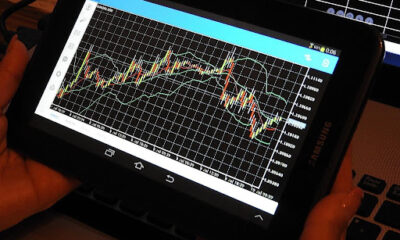Business News
What Is the Best App to Use for Day Trading?
Published
1 year agoon

Do you ever feel you need the right tools to make well-informed decisions when it comes to day trading? Do you want to learn how to ensure your investments are successful and profitable? You’re not alone.
With so many different apps available on the market today, it can take time and effort to pick the one that fits your experience level and needs.
This article will dive into all things day trading, discuss which app is ideal for beginners and more skilled traders, and reveal some of our top tips for success. So buckle up and get ready – let’s start learning how to maximize your gains with the best app for day trading.
What is day trading?
Day trading is an exciting investing strategy that could lead to significant financial gains. It involves purchasing and selling securities on the same day to capitalize on short-term price fluctuations, usually within a few hours or even minutes. To succeed at day trading, one must possess an intricate understanding of market trends and an analytical mind that can rapidly determine when to buy and sell.
Day traders must also be able to manage their emotions during fast-paced trades to stay focused and not let fear play a role in their decisions. Despite its high stakes, day trading has substantial potential rewards, making it appealing to many investors.
How to choose the best day trading app?
The best day trading app depends on your experience level and financial goals. Nevertheless, a few apps stand out from the competition and offer the most comprehensive tools for day trading success.
Traders looking to start day trading should consider MetaTrader 4 (MT4). This popular platform enables users to open and close trades quickly, track market data in real time and analyze tens of different currency pairs at once. MT4 also offers built-in tutorials to help newcomers learn the ropes, enabling them to build their day trading skills from scratch.
Advanced day traders should consider Robinhood; a top option for managing day trading accounts. This app features an intuitive interface, fast trade execution, and convenient access to a wide range of markets across the US. It also provides customizable charts, real-time market data, and day trading alerts, helping users make informed decisions in seconds.
How do day trading apps help you become a successful day trader?
Day trading apps have various powerful tools to help you succeed in the markets. They can provide detailed insights into market movements and trends, enabling users to make rapid decisions that capitalize on short-term gains.
These apps also enable day traders to manage their risk more effectively by utilizing features such as stop losses and limits, which can help prevent significant losses.
Many day trading apps offer customizable alerts that let you know when to enter or exit a position. It can be beneficial for those who can’t monitor the markets constantly.
What are the benefits of day trading apps?
Day trading apps come with various benefits designed to help you maximize your profits and minimize your losses. Here are some of the main advantages:
The main benefit of day trading apps is their convenience and speed. These apps can be accessed from anywhere with an internet connection, enabling you to take advantage of market opportunities as soon as they arise. Additionally, these apps have built-in tools to help you make informed decisions quickly, such as real-time market data and customizable alerts. It can allow you to capitalize on market movements as soon as they occur, helping you maximize profits.
Another benefit of day trading apps is their ability to help you manage risk more effectively. These apps usually come with features such as stop losses and limits, which can help prevent significant losses when the markets move against you. Additionally, many apps offer educational material to help you become more familiar with the markets and understand what drives price changes.
Day trading apps can help manage risk more effectively by allowing traders to set stop-losses and limits, which helps limit the losses incurred in case a trade goes against them.
What features should you look for in day trading apps?
When it comes to choosing the best day trading app for you, there are a few features that you should consider.
- Firstly, look for an app with intuitive navigation tools, making it easier for you to manage your trades and analyze market data quickly. Additionally, seek out apps with customizable displays so you can arrange the information in a way that works best for you.
- Additionally, look for apps with real-time market data and customizable alerts. These features will help you make more informed decisions faster, helping you maximize your profits. Additionally, look out for apps featuring educational material to help you become more familiar with the markets and understand what drives price changes.
- Finally, make sure that the app you choose offers secure trading. Check for various security measures, such as two-factor authentication and encryption, to help protect your account and personal data.
Wrapping up
Day trading apps are becoming increasingly popular amongst traders around the world. With the rise of technology, more investors are now using day trading apps to access markets, analyze data, and make trades. But with so many day trading apps available, it can be difficult to decide which one is right for you.
Overall, choosing the best day trading app is not an easy task. It requires careful consideration of several factors. For example, you must make sure the app is compatible with your device, offers the features and tools necessary to help you make informed trading decisions, is affordable, and offers the security and reliability needed to keep your funds safe. Ultimately, the best day trading app for you is the one that meets all of your needs and helps you to successfully manage your trades. Day trading and CFD trading are an important investment strategies and having the right app can make all the difference.
Is the CEO/Founder of Investors King Limited. A proven foreign exchange research analyst and a published author on Yahoo Finance, Businessinsider, Nasdaq, Entrepreneur.com, Investorplace, and many more. He has over two decades of experience in global financial markets.

You may like
-


The Impact of Global Politics on Forex Trading
-


Seasonal Trading: How to Take Advantage of Seasonal Trends in Trading
-


SEC Blacklists Six Forex Trading Platforms for Illegal Activities
-


Is CMC Markets a Good Broker?
-


What is Autotrading in Metatrader 5?
-


Naira Closes the Week With 0.3% Appreciation Against US Dollar

What is Affiliate Marketing?
In the landscape of marketing, affiliate marketing has drastically changed the ways in which business and individuals can promote their products. By definition, affiliate marketing is when affiliates, or those associated with a company or product, earn commissions for driving sales through their own marketing efforts.
While affiliate marketing has always been around, the rise of the internet and social media has led this type of marketing to soar in a unique way. An example of affiliate marketing in the wild is a company such as Amazon. When consumers purchase a product from Amazon, Amazon has an affiliate marketing program in which consumers can link photos and product reviews. Amazon then tracks the links of those that earn the most purchases, and those individuals can be compensated in some way for the business that they generate. Other notable companies that have affiliate marketing programs include Etsy, eBay, and BuzzFeed.
How Does Affiliate Marketing Work Step-by-Step?
If you are looking to understand affiliate marketing, it is important to begin with a solid understanding of the shareholders. Affiliate marketing is a relationship between the following individuals:
- Affiliate: As previously discussed, an affiliate is a person who promotes a product or service, typically in a digital manner. Affiliates have unique affiliate links that allow the parent company the opportunity to track how much traffic that individual affiliate’s marketing brings in.
- Merchant:The merchant is the product or service. This is the product or service that the affiliate is looking to promote. Merchants can be large companies, entrepreneurs or vendors.
- Consumer: The consumer is the individual who is brought in by the affiliate. The consumer then makes a purchase to the merchant, using the affiliate’s link.
Affiliate marketing is a cycle relationship between these three individuals. To fully comprehend affiliate marketing, it is important to understand the cause and effect relationship that these three entities have on one another.
How Do Beginners Get Into Affiliate Marketing?
If your interest has been piqued, and you are looking to perhaps get into affiliate marketing, you’ve come to the right place. The first step in entering the realm of affiliate marketing as an affiliate is finding your area of expertise. In order to promote a product or service, you will have a better chance at success if you promote something that you are familiar with and are passionate about. This will also make it far easier for you to create content about this product.
After you have established your niche, follow the below steps to continue exploring affiliate marketing:
- Research:The next step is to research affiliate programs. It is important to note that in order to partake in affiliate marketing, you need to find a company or product with an affiliate marketing program. The best way to find affiliate programs is by searching online, checking referral links from other affiliates and looking into the companies that are associated with products that you love.
- Build: Once you are officially an affiliate with an established program, you should begin to build your platform. Brainstorm what type of platform you want to work on. You have a variety of platform options, including blogs, websites, YouTube channels, Instagram pages, TikTok pages, or Facebook pages.
- Create: The next and final step in this equation is to begin creating your quality content! This is the fun part. Your content should fall in line with any rules or regulations of your merchant. It is important when you are first beginning to create content that you work on your ethos, and establish trust with your audience. Check out these digital marketing tips for how to create quality content!
How Much Money Can I Make Through Affiliate Marketing?
When it comes to just how much money you can make through affiliate marketing, the answer varies. This answer hinges on several factors, including:
- Niche: First, it depends on what type of content you are creating! Certain types of content and areas of expertise will draw in more money than others.
- Audience:Establishing a relationship with your audience is one of the first steps in creating good content. This is true for many reasons, but particularly because your audience determines your success. The more traffic you get through your links, the more money you can make.
- Content Quality: You must create quality content in order to get a strong fan base.
- Your Affiliate Program:It is important to research your different affiliate programs and find one that works best for you. Carefully research the terms and conditions of these programs, and pay special attention to the commission rates and payment structures of various companies.
According to LinkedIn, an experienced affiliate marketer can make anywhere from $1,000 to $10,000 per month. This is a wide range, and hence the reason why it is so important to do your research and establish a strong relationship with your audience.
The Pros and Cons of Affiliate Marketing
There are significant upsides as well as items to consider if you are looking to get involved with affiliate marketing. Some of the significant advantages to affiliate marketing include:
- Cost Effective
- Additional Income
- Freedom of Choice
A huge benefit to affiliate marketing is there are relatively low startup costs. Particularly if you are partnered with a product or service that you are already familiar with, you can start creating content with items that you likely already have. Affiliate marketing is a great way to earn extra income which can help you reach both short and long-term savings goals. Lastly, affiliate marketing offers you a wide range of options when it comes to how you will earn your money. You have the freedom and flexibility to invest your time in whatever products or services interest you!
However, it is also important to consider other aspects of affiliate marketing, such as:
- Competition
- Program-dependent
- Instability
Because affiliate marketing is so popular, this means that you are not the only player in the game! Not only do you need to create content, but you need to ensure you are working to create quality content that sets you apart from the crowd. In addition, affiliate marketing is also dependent on the merchant’s affiliate marketing program. As much as we would all like to promote our favorite products, you need to ensure you are partnering with an established program. Finally, while affiliate marketing can be a good way to earn additional income, it is hard to predict just how much money you will be able to make. This can affect your budget and make financial planning difficult! If you need to discuss debt and finances with a financial agent, contact LoanMart.
Overall, you will find that if you are willing to put in the time, effort and dedication, affiliate marketing can work for you!

Investing is a powerful tool for building wealth and securing your financial future. However, it can often seem overwhelming to beginners.
This comprehensive guide will break down the essentials of investing, covering how to get started, where to invest, and who should consider investing. By the end of this article, you’ll have a clearer understanding of how to navigate the investment landscape.
Why Invest?
Investing is essential for growing your wealth over time. Unlike simply saving money in a bank account, investing allows your money to work for you, potentially providing returns that outpace inflation and increase your overall financial standing.
Inflation erodes the purchasing power of your money over time. By investing, you can generate returns that outstrip inflation, ensuring that your money maintains or grows in value.
Whether you aim to buy a home, fund your children’s education, or retire comfortably, investing helps you achieve these goals by growing your wealth over the long term.
How to Start Investing
Before you start investing, it’s crucial to set clear, specific, and achievable financial goals. Determine what you want to achieve and when you hope to reach these milestones. This will guide your investment strategy and help you stay focused.
Assessing Risk Tolerance
Understanding your risk tolerance is vital. Risk tolerance is the degree of variability in investment returns that you are willing to withstand. Some people are comfortable with high-risk investments that might offer higher returns, while others prefer safer, lower-return options. Assess your comfort level with potential losses and gains to determine your risk tolerance.
Creating a Budget
To know how much you can invest, you need to create a budget. Track your income and expenses to determine how much you can comfortably allocate to investments each month without compromising your day-to-day financial needs.
Building an Emergency Fund
Before you start investing, ensure you have an emergency fund in place. This fund should cover three to six months’ worth of living expenses and be easily accessible in case of unexpected events. Having this safety net allows you to invest with more confidence.
Choosing an Investment Strategy
Your investment strategy should align with your financial goals, risk tolerance, and time horizon. Common strategies include conservative (low risk, stable returns), moderate (balanced risk and returns), and aggressive (high risk, high potential returns). Choose a strategy that fits your unique situation.
Where to Invest
Stocks represent ownership in a company. When you buy a stock, you become a shareholder and gain the potential to earn dividends and benefit from stock price appreciation.
Pros: High potential for returns, dividends, and ownership in companies.
Cons: High volatility, the potential for significant losses, requires ongoing research.
Bonds
Bonds are debt securities issued by corporations, municipalities, or governments. When you purchase a bond, you are lending money to the issuer in exchange for periodic interest payments and the return of the bond’s face value at maturity.
Pros: Lower risk compared to stocks, regular income through interest payments, relatively stable returns.
Cons: Lower potential returns, interest rate risk, inflation risk.
Real Estate
Real estate investing involves purchasing property to generate rental income or appreciate in value. This can include residential, commercial, or industrial properties.
Pros: Potential for steady income, appreciation, tangible assets, and tax benefits.
Cons: High initial investment, ongoing maintenance costs, market volatility.
Who Should Consider Investing
Starting to invest early allows you to take advantage of compound interest, where the returns on your investments generate their own returns over time. This exponential growth can significantly enhance your wealth over the long term.
Young professionals can consider a mix of stocks, mutual funds, and ETFs to build a diversified portfolio that balances risk and reward.
Mid-Career Individuals
At this stage, it’s important to diversify your investments to spread risk. This means investing in a variety of asset classes, including stocks, bonds, real estate, and perhaps some alternative investments.
Mid-career individuals should focus on balancing growth and stability, with a mix of equities and fixed-income investments.
Pre-Retirees and Retirees
As retirement approaches, managing risk becomes crucial. Protecting the wealth you’ve accumulated while still achieving modest growth is key.
Consider more conservative investments like bonds, dividend-paying stocks, and real estate that offer steady income with lower risk.
Individuals with High-Risk Tolerance
If you’re comfortable with higher risk, you can explore investments like growth stocks, cryptocurrencies, and venture capital. These have the potential for significant returns but also come with substantial risks.
Individuals with Low-Risk Tolerance
Conservative investors should focus on safer options like high-quality bonds, index funds, and dividend-paying stocks. These investments offer more stability and lower potential for loss.
Accredited Investor Verification
Accredited investor verification is crucial for ensuring compliance with SEC regulations and safeguarding the integrity of investment opportunities. Accurate verification helps maintain a trustworthy investment environment, protecting both investors and issuers from potential fraud and legal complications. Using reliable verification methods, whether through self-certification, third-party services, or digital platforms, ensures that only eligible investors participate in exclusive investment opportunities.
Conclusion
Investing is a crucial component of building and securing your financial future. By understanding the basics of how to start, where to invest, and who should consider investing, you can make informed decisions that align with your financial goals. Remember to diversify your investments, maintain a long-term perspective, and seek professional advice when needed. Start your investment journey today and take control of your financial destiny.

Cryptocurrency exchanges and stock exchanges share a common goal – facilitating trade. However, the way assets are traded, market volatility, and various other factors set these two types of exchanges apart.
In this article, I will explore the key differences between cryptocurrency and stock exchanges, aiming to help you make an informed investment decision in Nigeria.
Understanding Crypto and Stocks
Before we delve into the comparison, let’s first understand what cryptocurrencies and stocks are. In today’s financial landscape, both cryptocurrencies and stocks play vital roles in investment portfolios.
An Overview of Cryptocurrencies
Cryptocurrencies, such as Bitcoin and Ethereum, are digital or virtual currencies that use cryptography for secure transactions, control the creation of new units, and verify the transfer of assets. These digital assets operate on decentralized networks called blockchains, which record and validate transactions. Cryptocurrencies offer potential benefits such as increased privacy, lower transaction fees, and the ability to bypass traditional financial intermediaries.
Understanding Stocks
On the other side of the financial spectrum, stocks represent ownership in individual companies. When you buy stocks, you become a shareholder and have a claim to a portion of the company’s assets and earnings. Stocks are typically traded on stock exchanges, allowing investors to trade shares and potentially benefit from the company’s growth and dividends. Investing in stocks offers the opportunity to participate in the success of established companies and potentially earn income through dividends or capital gains.
Now that we have a basic understanding of cryptos and stocks, let’s dig deeper into the pros and cons of each investment option, helping you make an informed decision based on your financial goals in Nigeria.
Pros and Cons of Investing in Cryptocurrencies
When considering investment options, cryptocurrencies have gained significant attention in recent years. Investing in cryptocurrencies can offer several advantages, but it also comes with its fair share of risks. In this section, we will explore both the advantages and disadvantages of cryptocurrency investment.
The Advantages
- Potential for High Returns: Cryptocurrencies have shown the potential for substantial returns, with some investors achieving significant profits in a short period of time.
- Decentralized Nature: One of the key advantages of cryptocurrencies is their decentralized nature, which means they are not controlled by any central authority or government.
- Market Accessibility: Cryptocurrency markets are open 24/7, allowing investors to trade at any time, providing flexibility and convenience.
- Diversification: Cryptocurrencies offer an opportunity to diversify investment portfolios, providing an alternative asset class separate from traditional stocks and bonds.
The Risks
- Volatility: The value of cryptocurrencies can be highly volatile, which can lead to substantial swings in prices. This volatility can result in both profiting and losing opportunities.
- Security Concerns: Cryptocurrency investments are susceptible to hacking, fraud, and security breaches. Investors must take necessary precautions to secure their digital assets.
- Limited Regulation: Cryptocurrencies are not yet regulated in many countries, including Nigeria. This lack of regulation can lead to potential risks as scams and fraudulent activities may go unchecked.
- Market Speculation: The cryptocurrency market is often influenced by speculation and hype, which can lead to irrational price movements.
Pros and Cons of Investing in Stocks
When it comes to investing, traditional stocks have always been a popular choice among investors. Let’s explore the benefits and drawbacks of investing in stocks and understand why they continue to be an attractive investment option.
The Benefits of Stock Investment
- Potential for Long-Term Growth: Investing in stocks allows you to participate in the growth of established companies over time. Historically, stocks have shown the potential for significant returns, especially when held for the long term.
- Dividend Income: Many stocks pay dividends, which are a portion of the company’s profits distributed to shareholders. Dividends can provide a steady income stream, making stocks an attractive option for those seeking regular cash flow.
- Market Stability: While stocks can experience short-term volatility, the overall stock market tends to be more stable compared to the highly volatile cryptocurrency market. This stability can provide a sense of security for investors.
- Market Access: Investing in stocks offers easy accessibility for investors, with a wide range of stocks available for purchase on various stock exchanges. This accessibility allows investors to diversify their portfolio and choose from a diverse range of industries and companies.
The Risks of Stock Investment
- Market Fluctuations: Stock prices can be influenced by market fluctuations, which can result in temporary declines in the value of your investments. It’s important to be prepared for short-term volatility and not be swayed by market noise.
- Economic Downturns: During economic downturns, stock markets can experience significant declines. These downturns can impact the value of your stock investments, requiring patience and a long-term perspective to ride out the storm.
As with any investment, it’s essential to do thorough research and consider your risk tolerance before investing in stocks. Diversification and a long-term investment horizon can help mitigate risks and increase the potential for long-term returns.
Crypto vs. Stock Performance Over Time
When considering investment options, it is important to evaluate the historical performance and long-term growth potential of cryptocurrencies and stocks. This section will analyze the performance of both investment options over time and provide valuable insights for making informed decisions.
Historical Performance Comparison
Examining the historical performance of cryptocurrencies and stocks reveals interesting trends. Cryptocurrencies, such as Bitcoin and Ethereum, have experienced significant volatility and rapid price appreciation in recent years. This has attracted investors seeking high returns in a relatively short period.
On the other hand, stocks have a proven track record of delivering consistent long-term growth. Companies like Apple, Amazon, and Microsoft have seen their stock prices rise steadily over the years, rewarding patient investors with substantial gains.
Factors Impacting Long-Term Growth
Several factors contribute to the long-term growth potential of cryptocurrencies and stocks. For cryptocurrencies, the market volatility, regulatory uncertainties, and the evolving technology landscape play significant roles in determining their future growth trajectories.
Stocks, on the other hand, benefit from the stability and resilience of well-established companies, as well as their ability to generate profits and pay dividends to shareholders. Additionally, stocks offer the advantage of being backed by legal frameworks and regulations that provide a sense of security for investors.
Choosing the Right Investment
When comparing the historical performance and long-term growth potential of cryptocurrencies and stocks, it is essential to consider your investment goals and risk tolerance. If you are comfortable with the potential high volatility and are seeking short-term gains, cryptocurrencies may be appealing.
However, if you prioritize stability, steady growth, and the opportunity to participate in the success of established companies, stocks may be the better choice. Additionally, diversifying your investment portfolio by including a combination of cryptocurrencies and stocks can help mitigate risk and capture growth opportunities from both sectors.
Comparing Risk Factors: Crypto vs. Stocks
Risk assessment plays a crucial role in making sound investment decisions. When comparing cryptocurrencies and stocks, it is essential to consider the unique risk factors associated with each option. Let’s explore some of the key risk considerations:
Volatility
Cryptocurrencies are well-known for their high volatility. The value of popular cryptocurrencies, such as Bitcoin and Ethereum, can experience significant fluctuations within short periods. This volatility presents both opportunities for substantial gains and risks of sudden price drops. On the other hand, stocks generally exhibit lower volatility, although individual stocks can still experience price swings based on market conditions and company performance.
Diversification
Diversification is a risk management strategy that involves spreading investments across different assets to reduce exposure to any single investment. In the case of stocks, diversification can be achieved by investing in a mix of companies across various sectors. This helps to mitigate the risk of poor performance by any one company. However, diversifying within cryptocurrencies can be challenging due to the limited number of established options. Nevertheless, a well-diversified portfolio should ideally include a mix of both cryptocurrencies and stocks to balance risk and potential returns.
“Diversification is a fundamental aspect of managing risk in any investment portfolio. By diversifying across different asset classes, such as cryptocurrencies and stocks, investors can potentially minimize the impact of market fluctuations and protect their capital.” – John Smith, Financial Advisor
Regulatory Factors
Regulatory oversight can have a significant impact on both cryptocurrencies and stocks. Cryptocurrencies operate in a relatively new and evolving regulatory landscape, with different countries having varying degrees of acceptance and regulation. Changes in regulations or government actions can impact the value and legality of cryptocurrencies. On the other hand, stocks are subject to regulatory frameworks that aim to ensure fair trading practices and protect investors. These regulations provide a level of transparency and stability for stock investments.
Market Accessibility
Investing in cryptocurrencies offers individuals the opportunity to participate in a global market accessible 24/7. This accessibility provides convenience and flexibility but also increases the potential risk of trading in a market that never sleeps. On the contrary, investing in stocks typically involves trading within established stock exchanges during specific market hours. This can offer a more structured and regulated environment for investors.
Considering the various risk factors, it is important to thoroughly assess your risk tolerance and investment goals when deciding between cryptocurrencies and stocks. Understand that each option carries its own unique risks and rewards. By diversifying your portfolio and conducting thorough risk assessments, you can make informed decisions that align with your financial objectives.
Final Takeaways:
- Cryptocurrencies provide global market accessibility and operate 24/7, offering convenience for investors in Nigeria.
- Stocks are subject to regulatory frameworks, providing investors with a sense of security and transparency.
- Cryptocurrencies offer the potential for higher short-term gains but come with a higher level of risk.
- Stocks may provide a more stable and predictable return over the long term, particularly for established companies.
Conclusion
After carefully evaluating the key aspects of investing in cryptocurrencies and stocks, it is clear that both options have their merits and drawbacks. When considering crypto vs. stocks, it is important to remember that cryptocurrencies offer the potential for high returns and operate in a decentralized system. However, they also come with significant volatility and security risks. On the other hand, investing in stocks can provide dividends, market stability, and the potential for long-term growth. But stocks are also susceptible to market fluctuations and economic downturns.
Trending
-

 Billionaire Watch3 weeks ago
Billionaire Watch3 weeks agoWarren Buffett Donates $5.3 Billion in Berkshire Shares to Charities
-

 Startups4 weeks ago
Startups4 weeks agoFormer Konga CEO Nick Imudia Dies by Suicide in Lagos Home
-

 News4 weeks ago
News4 weeks agoJoke Silva Quashes Death Rumors, Confirms Olu Jacobs is Alive
-

 News4 weeks ago
News4 weeks agoNorth Israel Turns Into Ghost Towns Amid Hezbollah Missile Barrage
-

 Bitcoin4 weeks ago
Bitcoin4 weeks agoBitcoin Slumps 13% in Q2, Prompting Investor Concerns
-

 Naira4 weeks ago
Naira4 weeks agoNigeria’s Foreign-Exchange Woes Intensify with Prolonged Naira Decline
-

 Forex3 weeks ago
Forex3 weeks agoNigerian Banks Face Sanctions for Rejecting Small and Old US Dollar Notes
-

 Treasury Bills4 weeks ago
Treasury Bills4 weeks agoCBN Treasury Bills Auction Oversubscribed by 338%, Raises N284.26bn

















